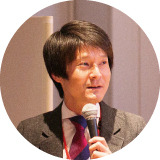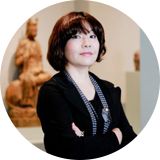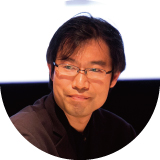Special Screening+Talk Show
Identity Issues in Singapore and Malaysia Seen through Films Talk show(1/3)


Welcome, everyone. Thank you for joining us for “Identity Issues in Singapore and Malaysia Seen through Films.” Today and next week, we will be screening Singaporean and Malaysian films as the pre-event for the SUNSHOWER: Contemporary Art from Southeast Asia 1980s to Now exhibition which will be held this year simultaneously at the National Art Center, Tokyo and Mori Art Museum from July to November. Today, along with the screenings, we will have a talk featuring two guests who are well-acquainted with the culture and social circumstances of Singapore and Malaysia, as well as curators from the two venues of the exhibition.
First, Mr. Naoki Yoneda, the curator from the National Art Center, Tokyo, will present a summary of the exhibition and its relationship with “identity.”
We are planning to have nine thematic chapters in totals for the exhibition, one of which is “Diverse Identities.” We, the organizers of the event, have conducted research in each ASEAN country for the past two years in preparation for the “SUNSHOWER” exhibition. These were divided among the fourteen of us—ten curators from both the National Art Center, Tokyo and Mori Art Museum, and four young curators from the Southeast Asia region. Ms. Kataoka and I both visited all ten ASEAN countries, and through our research, we found that many artists in each country were addressing the issues of “identity” in many forms of their practices. Inevitably, we ended up choosing this theme. In fact, there are many Singaporean and Malaysian artists in this “Diverse Identities” chapter, and my personal impression was that many Singaporean artists in particular were questioning their own identities through their works. Boo Junfeng, who is the director of Sandcastle that we screened just now, is one of those artists. Boo is active as a film director and artist, and we plan to exhibit his work at the “SUNSHOWER” exhibition.
For the “Diverse Identities” chapter, we turned our eyes toward different identities such as national, cultural, ethnic, and individual identities. Many countries in Southeast Asia gained their independence after World War II, and “nation building” has been their major theme for the past seventy years. The region also has a diverse range of cultures, languages, and religions, so we hope to introduce this diversity from various angles at the exhibition. One of these angles is represented by the “Diverse Identities” chapter.
I’d like to start by speaking about Sandcastle. Boo is thirty-three years old, born in 1983, and is a young director who is leading the film industry in Singapore. Personally, I felt that Sandcastle is a work that includes many elements relating to identity, including the challenges faced by the country of Singapore, its inhabitants, and the relationship between society and identity. Ms. Yumi Matsushita, who has joined us today, was the first to screen Sandcastle in Japan in 2012, as the producer of Sintok Singapore Film Festival in Tokyo. Ms. Matsushita, having watched it again today, how do you see this work from the perspective of identity?
I invited Boo to the first Sintok held in 2009, and screened his short film collection. At the time, he told me, “Dementia is one of the themes of the feature film that I am working on now, from my experience of seeing my grandmother suffer from the illness.” Sandcastle was completed after this. The process of the protagonist following his family’s tabooed past is portrayed, intertwined with Singapore’s history. The protagonist’s grandparents have roots in the Fujian Province—region in southern China where the majority of Chinese-Singaporeans come from—and they speak Hokkien. However, the younger generation speak Mandarin and/or English.
Sandcastle also depicts Singapore’s practice of National Service (NS: military conscription). NS starts after finishing high school or the equivalent level of education, and occupies a large role in the identity construction of Singaporeans. Thesong with lyrics that inspire patriotism, made for Singapore’s National Day, is used as a motif. Sandcastle also contains footages of when Singapore became an independent country, and of when students protestedagainst the prohibition of the Chinese language in schools.
When Sandcastle was being filmed, Boo was still in his early twenties, but it is a mature film. While it is loaded with the challenges that Singapore faces, it simultaneously incorporates stories of personal growth and love, making it an enjoyable film about youth and adolescence.

Mr. Ken Takiguchi has spent a total of seventeen years in Malaysia and Singapore, and is deeply familiar with performing arts in Singapore. Mr. Takiguchi, what are your thoughts on Sandcastle from a performing arts point of view or from your own experience living there?
I was a faculty member at the National University of Singapore until last year, so I have had many opportunities to speak with Singaporean students in their twenties. The year 2015 was the 50th anniversary of Singapore’s independence. Throughout the year, there were many discussions on, “What is Singapore?” and there were lively debates held at the university as well.
I watched Sandcastle while reminiscing on this and it made me feel somehow stuffy. What I mean is, I have a strong impression that Singapore is trying very hard to run itself and exist as a nation. It is a very peculiar country; an island that is only the size of the twenty-three central wards of Tokyo with very limited natural resources. When it declared independence from Malaysia in 1965, there was a famous instance in which the first Prime Minister, Lee Kuan Yew (1923 – 2015), started crying at a press conference . He had believed that if Singapore became independent, it could not make it on its own. Singapore, as a nation state, started from an extremely difficult state of affairs, in which it had no choice but to detach itself from the Federation of Malaysia, as if thrown out. This fact was mentioned repeatedly during the year of the 50th anniversary. When living in Singapore, I frequently encountered remarks tinged with a sense of crisis that if Singaporeans let down their guard for even a moment, their country could disappear.
Songs were created every year to celebrate Singapore’s independence. In Sandcastle, these “National Day Songs” such as “Stand Up for Singapore” which was made in 1984 and is still greatly loved today, and “Home” which is played at the beginning and the end of the film are used very effectively. I think that Singapore makes use of these songs that appeal to people’s sense of patriotism to shape its country, and that this experiment is repeated over and over again. While watching Sandcastle, I was thinking about all of these things: the difficulties that Singapore faces, the sense of constant urgency or burden of how they must make their country for themselves, and how they must always establish their own identities.
Ms. Matsushita, through actually working with Boo, what impressions did you get about the director’s motivations behind the film? You mentioned Singapore’s military conscription, but could you give us some more details on what [you think] he was trying to communicate [to the audience]?
In Singapore, “conscientious objection” is not accepted, and apparently you could be penalized or fined if you don’t comply. Even if you go on a study abroad, you must either fulfill your NS or a jail sentence once you return. And, even after you complete your service, you are summoned every year as a reserve soldier. The country is small, so some can commute from their homes, and it is said that it isn’t as severe compared to other countries. Nevertheless, this NS to which Singaporean men must offer their youths to plays a major role in their lives.
Next there is the theme of language and identity. When Singapore declared independence, Prime Minister Lee believed that globalization was indispensable in order for Singapore to survive and he officialized a bilingual policy that promoted English and the other languages of each ethnicity. However, even among Chinese-Singaporeans there are several different dialects and no common language among [all of] them. That is why the “Speak Mandarin Campaign” started in 1979. Through this effort to get everyone to speak Mandarin, although it was artificial, Chinese-Singaporeans started to speak a shared, common version of the Chinese language. I have heard that when they travel to mainland China, they are called foreigners because of differences in accents, and so they started to wonder exactly what nationality they were. On the other hand, immigrants from China have also been pouring into Singapore. The protagonist of the film has a line in which he says, “We are immigrants as well, aren’t we?” Although they are of Chinese origin, there still seems to be friction between recent immigrants who grew up in a different environment with a different education system. Furthermore, the younger generation has become unable to speak the regional dialects of China. In Sandcastle, even though the grandchild [protagonist] can understand what his grandparents are saying, he cannot speak their dialect. However, since the “Speak Mandarin Campaign,” the number of Mandarin-speakers has risen, and the policy has worked to strengthen cultural and economic ties and influence as a part of Greater China.
That’s fascinating. I felt that the protagonist of Sandcastle faces various other identity issues besides the military and linguistic problems that you just spoke of. Mr. Takiguchi, do you think these are general trends among Singaporeans of the same age?
I cannot say that I have completely grasped how my students feel, but one thing I can say is that Singapore is still a young country, as it has only been fifty years since its founding. Just as Ms. Matsushita was saying, I think that Singapore has definitely implemented various sorts of experiments. Be it their language [policy], as soon the country declares a national policy for their students to “Speak English,” English became a sole medium of education. In Sandcastle, the protagonist’s father participated in a movement protesting against the abolishment of the Chinese-speaking curriculum in schools, and I think this is really characteristic of Singapore: to make these kinds of extremely drastic changes at the discretion of the nation. However, repeating such changes results in a certain discontinuation, I think, such as different generations no longer sharing the same language, or several different languages being spoken in a single household. I think the students I met fully accept the fact they are a product of such “experiments.” Especially the male students; as they all enter university after completing their military services, they fully think through their paths from being a soldier to a university student. I could see their resolve from their attitudes. In that sense, I feel that the protagonist’s thoughts very accurately depict what young Singaporeans are going through today.

The audience of approximately 150 was asked for reasons for coming to this talk. The majority raised their hands for their “Interest in film” and “Interest in Singaporean and Malaysian culture and society.”




